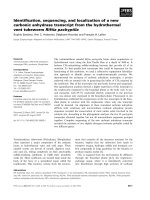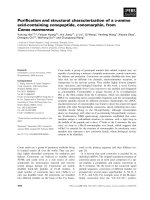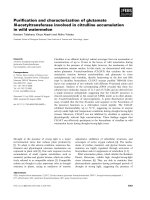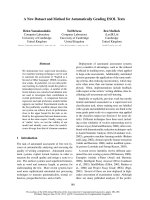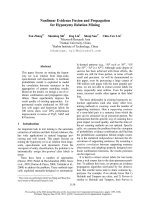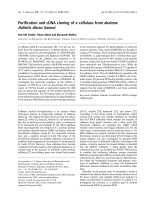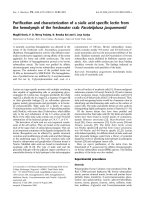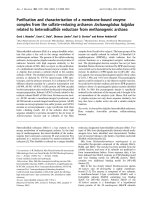Báo cáo khoa học: Purification, microsequencing and cloning of spinach ATP-dependent phosphofructokinase link sequence and function for the plant enzyme pdf
Bạn đang xem bản rút gọn của tài liệu. Xem và tải ngay bản đầy đủ của tài liệu tại đây (994.55 KB, 10 trang )
Purification, microsequencing and cloning of spinach
ATP-dependent phosphofructokinase link sequence and
function for the plant enzyme
Christian Winkler, Britta Delvos, William Martin and Katrin Henze
Institute of Botany III, University of Du
¨
sseldorf, Germany
Phosphofructokinase (PFK) catalyzes the phosphoryla-
tion of d-fructose 6-phosphate to d-fructose 1,6-bis-
phosphate. The enzyme has been extensively studied in
a wide spectrum of prokaryotes and eukaryotes [1–7].
At least three forms of PFK are known that differ with
respect to the phosphoryl donor. The classical PFK of
mammals, yeast and eubacteria, a key enzyme of glyco-
lysis, is ATP-dependent and subject to extensive allos-
teric regulation by various metabolites [8,9]. In plants,
various protists, and some prokaryotes, pyrophosphate
(PP
i
)-dependent forms of PFK are known (EC 2.7.1.90)
[10–13]. These enzymes share sequence similarity with
ATP-dependent PFK (ATP-PFK) and are designated
either as PP
i
-PFK or as pyrophosphate:fructose-6-
phosphate 1-phosphotransferase. They differ markedly
with respect to their regulatory properties across
species. Plant PP
i
-PFK is subject to extensive allosteric
regulation, in particular by fructose 2,6-bisphosphate
[14], whereas the enzyme from various anaerobic pro-
tists is not [10,15]. Notably, ATP-dependent and PP
i
-
dependent PFKs interleave in molecular phylogenies,
indicating that several independent changes of cosub-
strate specificity have occurred during PFK evolution
among eubacteria [16–18], among archaebacteria [2],
and among eukaryotes [4]. A third form of PFK has
been reported only from archaebacteria. It is ADP-
dependent (ADP-PFK), belongs to the the ribokinase
superfamily, typically occurs among archaebacteria that
lack an Embden–Meyerhof pathway [19,20], and can
accept acetyl phosphate as the phosphoryl donor [21].
Keywords
ATP-PFK; sequence; subunits
Correspondence
K. Henze, Institute of Botany III, University
of Du
¨
sseldorf, D-40225 Du
¨
sseldorf,
Germany
Fax: +49 211 811 3554
Tel: +49 211 811 2339
E-mail:
Database
The sequences reported here have been
submitted to the GenBank database under
the accession numbers DQ437575 and
DQ437576
(Received 5 October 2006, revised 7
November 2006, accepted 10 November
2006)
doi:10.1111/j.1742-4658.2006.05590.x
Despite its importance in plant metabolism, no sequences of higher plant
ATP-dependent phosphofructokinase (EC 2.7.1.11) are annotated in the
databases. We have purified the enzyme from spinach leaves 309-fold to
electrophoretic homogeneity. The purified enzyme was a homotetramer of
52 kDa subunits with a specific activity of 600 mUÆmg
)1
and a K
m
value
for ATP of 81 lm. The purified enzyme was not activated by phosphate,
but slightly inhibited instead, suggesting that it was the chloroplast iso-
form. The inclusion of adenosine 5¢-(b,c-imido)triphosphate was conducive
to enzyme activitiy during the purification protocol. The sequences of eight
tryptic peptides from the final protein preparation, which did not utilize
pyrophosphate as a phosphoryl donor, were determined and an exactly
corresponding cDNA was cloned. The sequence of enzymatically active
spinach ATP-dependent phosphofructokinase suggests that a large family
of genomics-derived higher plant sequences currently annotated in the data-
bases as putative pyrophosphate-dependent phosphofructokinases accord-
ing to sequence similarity is misannotated with respect to the cosubstrate.
Abbreviations
ATP-PFK, ATP-dependent phosphofructokinase; PFK, phosphofructokinase; PP
i
, pyrophosphate; SoPFK, Spinacia oleracea
phosphofructokinase.
FEBS Journal 274 (2007) 429–438 ª 2006 The Authors Journal compilation ª 2006 FEBS 429
Higher plant ATP-PFK remains more elusive than
its counterparts from other sources. In 1975, Latzko &
Kelly [22] reported the existence of chloroplast- and
cytosol-specific isoenzymes in spinach. Since then, the
isoforms of ATP-PFK from various plant sources have
been studied [23–34]. Spinach cytosolic ATP-PFK is
activated by 25 mm phosphate, whereas the chloroplast
enzyme is slightly inhibited [27,28,30–32]. Various
effectors, including ADP, phosphoenolpyruvate,
3-phosphoglycerate, and phosphoglycolate, have been
reported [27–29], and both the chloroplast and the
cytosolic enzymes can accept ribonucleoside triphos-
phates other than ATP as the phosphoryl donor
[35,36]. Chloroplast and cytosolic ATP-PFKs have also
been partially purified and characterized from various
green algae [29,37,38].
Higher plants also possess PP
i
-PFK [23,24], which
occurs only in the cytosol [33,34]. The subunit structure
and sequence of higher plant a
2
b
2
heterotetrameric
PP
i
-PFK are known [12,39], but corresponding
information about plant ATP-PFK is not available.
ATP-PFK from potato tubers was purified to apparent
homogeneity; the final prepartion was reported to con-
sist of four different subunits (PFK
a–d
) with molecular
masses of 46 300, 49 500, 50 000 and 53 000 kDa,
respectively [33]. More recently, two isoforms of ATP-
PFK from banana fruit with native molecular masses of
210 and 160 kDa, respectively, but of unknown subunit
composition, were partially purified [34]. However,
plant ATP-PFK activity has never been experimentally
linked to any specific protein sequence, because no puri-
fied ATP-PFK from any plant source has been
sequenced to date, and nor has ATP-PFK activity been
demonstrated for any putative plant ATP-PFK gene
product by recombinant expression in heterologous sys-
tems. Although sequence comparisons have suggested
that some database entries currently annotated as puta-
tive PP
i
-PFK might in fact correspond to ATP-depend-
ent enzymes [40], experimental evidence to support this
suggestion is lacking. Here we report the purification
of ATP-PFK from spinach leaves to electrophoretic
homogeneity, its sequence, subunit composition, and
putative chloroplast localization, and comparison with
PFK sequences from other sources.
Results and Discussion
Purification and microsequencing of spinach PFK
The present purification protocol combined elements
from previously published PFK purification protocols
[6,33–35]. Anion exchange chromatography of crude
extract from whole cells on DEAE Fractogel yielded
only one peak of enzyme activity. This activity was
further purified by gel filtration, sucrose gradient
centrifugation, reactive dye affinity chromatography, and
a MonoQ column (Table 1). A final step of hydroxyl-
apatite chromatography was necessary to completely
remove ribulose-1,6-bisphosphate carboxylase ⁄ oxidase
from the sample, the large subunit of which comigrated
with ATP-PFK in SDS ⁄ PAGE (Fig. 1). This step
yielded 309-fold purified ATP-PFK, but was accom-
panied by the loss of 93% of total activity (Table 1).
Table 1. Purification of spinach ATP-PFK.
Purification step
Total
activity
(mU)
Total
protein
(mg)
Specific
activity
(mUÆmg
)1
)
Purification
(fold)
Crude extract 60 000 30 000 2 –
DEAE-Sepharose 520 200 2.6 1.3
Sephacryl S-400 420 100 4.2 2.1
Sucrose gradient 214 22.8 9.4 4.7
Reactive red 214 4.64 46 23
Mono Q 166 0.63 264 132
Hydroxylapatite 13 0.021 619 309
Fig. 1. Silver-stained 12% SDS ⁄ PAGE of spinach PFK from dif-
ferent purification steps. Lane 1: crude extract. Lane 2: DEAE
fractogel eluate. Lane 3: Sephacryl S-400 HR eluate. Lane 4: con-
centrated protein after sucrose gradient centrifugation. Lane 5:
reactive red eluate. Lane 6: Mono Q eluate. Lane 7: hydroxylapatite
eluate. M: molecular mass standard (size indicated).
Plant ATP-dependent phosphofructokinase C. Winkler et al.
430 FEBS Journal 274 (2007) 429–438 ª 2006 The Authors Journal compilation ª 2006 FEBS
The final preparation contained a single, electrophoret-
ically homogeneous, protein of 52 kDa (Fig. 1).
The 52 kDa protein was excised from a Coomassie-
stained gel and digested with trypsin, and the resulting
peptides were analyzed by ESI-Q-TOF MS ⁄ MS, yield-
ing the sequences of eight different internal fragments
(Fig. 2). The sequence of fragment NLEGGSLLGTSR
is incomplete at the N-terminus, due to low resolution
of the spectrum (data not shown). Database searches
with the peptide sequences confirmed the purified pro-
tein as a member of the PFK family. Sequencing
revealed no peptides from ribulose-1,6-bisphosphate
carboxylase ⁄ oxidase, or peptides from any other pro-
tein, indicating that the 52 kDa band harbored ATP-
PFK as the single major constituent.
PCR with degenerate oligonucleotides based on the
sequences of peptides TIDNDILLMDK and YIDPTY
(Fig. 2) yielded a 500 bp amplification product that
was used as a hybridization probe for screening a Spi-
nacia oleracea cDNA library [41]. One positive clone,
pSoPFK2, was detected, sequenced, and found to be
N-terminally truncated, so its sequence was completed
by 5¢-RACE PCR. The conceptionally translated
sequence encoded by pSoPFK2 contained only one of
the eight peptide sequences determined from the puri-
fied protein (Fig. 2). New degenerate primers were
designed against the peptides LSGNAVLGDIGVHFK
and EIYFEPTK, and produced a PCR fragment of
750 bp that was cloned and sequenced. The coding
sequence was completed by 5¢- and 3¢-RACE, yielding
SoPFK1, which contained all eight peptides deter-
mined from the purified protein (Fig. 2). An in silico-
generated mass spectrum of tryptic peptides of
SoPFK1 predicted fragments with masses correspond-
ing to all eight sequenced peptides, confirming that the
purified ATP-PFK was identical with SoPFK1. Data-
base searching with SoPFK1 as a query revealed
strongest similarity to sequences annotated as putative
PP
i
-dependent PFKs from higher plants.
Properties of spinach ATP-PFK
The sequence of pSoPFK1 was 1829 bp long with an
ORF of 1509 nucleotides, encoding a predicted protein
Fig. 2. Deduced protein sequencees of PFK from Spi. oleracea cDNA clones. Peptide sequences directly determined by MS are highlighted.
The potential transit peptide is underlined, and the potential cleavage site is indicated by an arrow. Conserved regions for domains of atypical
ATP-PFK are borderd and supported by the Esc. coli PFK sequence [39].
C. Winkler et al. Plant ATP-dependent phosphofructokinase
FEBS Journal 274 (2007) 429–438 ª 2006 The Authors Journal compilation ª 2006 FEBS 431
of 503 residues (Fig. 2). The predicted molecular mass
of SoPFK1 was 55.5 kDa, which was slightly larger
than the 52 kDa determined for the purified protein.
This difference could be due to a cleaved transit pep-
tide for chloroplast targeting. SoPFK1 has an N-ter-
minal extension compared to SoPFK2 and Escherichia
coli PFK. The transit peptide-prediction programs
chlorop [43] and ipsort [42] did not recognize this
extension as a chloroplast targeting sequence, but
signalp [42] identified a potential peptidase cleavage
site (Fig. 2). Cleavage of the protein at this site would
yield a mature protein of 53 kDa, which would be in
better agreement with the size of the purified protein.
The protein encoded by pSoPFK2 had a calculated
molecular mass of 55.3 kDa. SoPFK2 and SoPFK1
shared 45% amino acid identity, predominantly due to
a conserved core region, but SoPFK1 was about 50
amino acids longer at the N-terminus and 57 amino
acids shorter at the C-terminus than SoPFK2 (Fig. 2).
Gel filtration of partially purified spinach PFK yielded
a molecular mass 200 kDa for the native enzyme
(Fig. 3), consistent with the native mass of 210 kDa
reported for banana PFKI [34].
Purified spinach PFK had a specific enzyme activity
of 600 mUÆmg
)1
with ATP as phosphoryl donor. The
enzyme did not utilize PP
i
as a cosubstrate (Fig. 4).
The K
m
was 1.7 mm for d-fructose 6-phosphate and
81 lm for ATP (supplementary Fig. S1), which was
significantly higher than the K
m
of 30 lm reported for
the cytosolic isoenzyme [28]. PFK activity was inhib-
ited by the addition of 25 mm phosphate (Fig. 4), a
typical feature of chloroplast ATP-PFK [27,28,32], and
in contrast to the stimulation of the cytosolic isoen-
zyme observed in spinach and other plants [27]. These
data suggest that the purified protein was the chloro-
plast isoenzyme, although the level of inhibition was
only 17%, and thus considerably lower than the 50%
reported previously [27,28]. This discrepancy could be
due to the fact that the protein was eluted with phos-
phate from the final hydroxylapatite column. Instabi-
lity of the protein prevented removal of the phosphate
from the PFK preparation by dialysis prior to activity
measurements and led to complete loss of activity, so
this question could not be answered.
Subunit composition
Previous purifications of plant ATP-PFK suggested
that the enzyme consists of two [33] or four [32,34]
Fig. 3. Elution profile for SoPFK1 after gel filtration chromatography
on a Superdex 200 HR 10 ⁄ 30 column. Marker protein sizes are indi-
cated by arrows.
Fig. 4. Spinach PFK activity assayed in the absence (black bar) or
presence (gray bar) of 25 m
M phosphate. The white bar shows pyro-
phosphate:fructose-6-phosphate 1-phosphofructokinase activity.
Plant ATP-dependent phosphofructokinase C. Winkler et al.
432 FEBS Journal 274 (2007) 429–438 ª 2006 The Authors Journal compilation ª 2006 FEBS
subunits with molecular masses between 50 and
70 kDa. Our final active preparation revealed a single
52 kDa subunit (Fig. 1). Eight peptides determined
from that protein all mapped to the cDNA sequence
of SoPFK1, and importantly, we obtained no
sequences of tryptic fragments that did not map to
SoPFK1. Together with the finding that gel filtration
yielded a molecular mass for the active enzyme of
200 kDa, this indicates that the purified spinach
enzyme is a homotetramer of 52 kDa subunits, sim-
ilar to the putative chloroplast enzyme from banana
fruit [34]. However, the specific activity of the electro-
phoretically homogeneous spinach enzyme is 10-fold
lower than that of banana, and 300-fold lower than
that of the PFKs from potato tuber, which consisted
of four different subunits [33]. It would seem likely
that the elution by phosphate, an inhibitor of the
chloroplast enzyme, contributes to the lower activity in
the final purification step [27,28,30]. Hence, we cannot
exclude the possibility that additional subunits, as
observed in potato, interact in the spinach tetramer
in vivo in such a way as to increase the specific activity,
and that these were removed during purification.
SoPFK2 could be such an additional subunit, but the
homogeneity of our final active preparation does not
suggest a heteromeric composition of the 200 kDa
enzyme purified here.
Our attempts to express the SoPFK1 subunit in active
form in the PFK-deficient PFK2 ⁄ PFK1 double mutant
yeast strain HD114-8D [5] under the control of the Gal
promoter in the plasmid pYES2 ⁄ CT failed to generate
strains possessing detectable ATP-PFK activity (data
not shown), although we obtained immunologically
detectable C-terminally His-tagged SoPFK1 in the sol-
uble fraction of transformants. The heat activation
treatment that was successfully used to restore highly
specific ATP-dependent activity of the Entamoeba
enzyme [6] also failed for the heterologously expressed
spinach protein. We are aware of no reports in which
plant ATP-PFK activity has been obtained via hetero-
logous expression in any system; the reasons for this
remain obscure. It is conceivable that the potential
N-terminal targeting peptide interfered with correct
folding of the protein or subunit interaction in the
heterologous system.
Higher plant ATP-PFK sequence comparisons
Spinach ATP-PFK clustered within the class of PFK
sequences that have been previously designated as
group II [1,2] in the larger scheme of PFK sequence
diversity, as sketched in Fig. 5A, where it is evident
that some organisms, such as the actinomycete
Amycolatopsis methanolica, possess two very distinct
PFK types [7]. Within group II, SoPFK1 clustered with
Oryza sativa and Arabidopsis thaliana PFK homologs,
as does SoPFK2 (Fig. 5B). In sequence alignments,
many of the group II plant enzymes show a long N-ter-
minal extension (labeled ‘Nex’ in Fig. 5B), which in
some cases are predicted as a chloroplast import signal
(labeled ‘pCp’) by chlorop 1.1 and ipsort [42,43], but
these sequences interleave with other homologs that
lack N-terminal extensions. SoPFK1 has an N-terminal
extension relative to prokaryotic homologs that is remi-
niscent of a chloroplast transit peptide, but the protein
was not predicted to be chloroplast targeted by chlo-
rop, although the N-terminal extension present in some
rice and Arabidopsis homologs did predict chloroplast
targeting (Fig. 5B). Nevertheless, signalp [44] predic-
ted a potential cleavage site between residues 18 and 19
(Fig. 2). The distribution of the presence of N-terminal
extensions and predicted chloroplast transit peptides
for plant PFK homologs did not correspond with
sequence similarity (Fig. 5B).
Among the published sequences that fall within the
cluster of sequence similarity designated here as group
IIa, there are few with demonstrated function, and only
ATP-dependent activity has been shown for members
of this group (Fig. 5B). PFK enzymes can change their
cosubstrate specificity for PP
i
or ATP through muta-
tions at a very few specific residues [1–4,39], and within
group II, both PP
i
- and ATP-dependent enzymes are
known (Fig. 5A,B), as are the residues that confer P P
i
or ATP dependence by virtue of cosubstrate inter-
actions at the active site [3,4]. The crucial residues,
Gly105 and Lys124, in the Esc. coli enzyme [45] are
conserved in the atypical and previously uncharacter-
ized ATP-dependent PFK sequences [3,4,6,39], and they
are also conserved in SoPFK1 and SoPFK2 (Fig. 2).
From these observations, we conclude that annotation
of PFK sequences with respect to their phosphoryl
donor specificity cannot be done on the basis of general
sequence similarity but has to be based on the amino
acid constellation at positions corresponding to
Esc. coli 105 and 124 and biochemical data.
With the notable exception of the Thermoproteus
tenax PP
i
-PFK [2], archaebacteria usually possess an
ATP- or ADP-dependent PFK that is highly distinct
from the eubacterial and eukaryotic enzyme, but
instead is related to ribokinases [19,20]. Perhaps the
most striking aspect of PFK gene diversity is the gen-
eral absence of the eukaryotic- and eubacterial-type
PFK among archaebacteria, and vice versa. This sup-
ports earlier conclusions [46], despite reports to the
contrary [47] that eukaryotes generally possess a
eubacterial type of glycolytic pathway [48].
C. Winkler et al. Plant ATP-dependent phosphofructokinase
FEBS Journal 274 (2007) 429–438 ª 2006 The Authors Journal compilation ª 2006 FEBS 433
Plant ATP-dependent phosphofructokinase C. Winkler et al.
434 FEBS Journal 274 (2007) 429–438 ª 2006 The Authors Journal compilation ª 2006 FEBS
Materials and methods
Strains and media
Escherichia coli strain XL1-Blue MRF¢ (Stratagene, Heidel-
berg, Germany) was used for plasmid handling. Saccharo-
myces cerevisiae strain AST9-1B (Mata pfk::LEU2
PFK1::TRP1 ura3-52 his3-11, 15 leu2-3, 112 trp1::loxP
Mal2-8c SUC 2 GAL), kindly provided by J J Heinisch
(University of Osnabru
¨
ck, Germany), was used as a recipi-
ent strain for heterologous expression of spinach PFK
enzymes.
Enzyme assay
PFK activity was determined spectrophotometricaly at
30 °Cin50mm Hepes ⁄ NaOH (pH 7.8), 0.5 mm MgCl
2
,
0.15 mm NADH, 0.6 mm ATP, 2 mm dithiothreitol, 10 U
of triose-phosphate isomerase, 1 U of glycerol-3-phosphate
dehydrogenase and 1 U of aldolase [49,50] in a final assay
volume of 200 lL (GENios Microplate Reader; Tecan
Instruments, Crailsheim, Germany). The reaction was initi-
ated by addition of 0.4 mmd-fructose 6-phosphate, and
activity was determined by decrease in absorbance at
340 nm. For discrimination between the chloroplast and cy-
tosolic isoforms, 25 mm NaH
2
PO
4
was added to the assay
[31,32]. For measurement of PP
i
utilization, ATP was sub-
stituted with 0.6 mm PP
i
, and 10 lm fructose 2,6-bisphos-
phate was added, because PP
i
-PFK is stimulated by
fructose 2,6-bisphosphate [51]. The K
m
for ATP was meas-
ured at a d-fructose 6-phosphate concentration of 0.4 mm
in the presence of 3 U of creatine kinase and 1 mm creatine
phosphate for continuous ATP regeneration. K
m
values
were determined with Hanes–Woolf plots.
Purification of spinach ATP-PFK
All procedures were carried out at 4 °C unless indicated
otherwise. Raw extract was prepared from 1.3 kg of 5–8-
week-old spinach leaves (Polka) by homogenization in a
Waring Blender (Torrington, CT, USA) using 250 mL of
50 mm Tris ⁄ HCl (pH 7.8), 2 mm dithiothreitol, 5 mm
MgOAc, 1 mm ATP, 0.1% (v ⁄ v) 2-mercaptoethanol, 10%
(v ⁄ v) glycerol, 1 mm iodoacetate, 10 g of Polyclar AT and
2.5 mL of 100 · Protease Inhibitor Mix (Sigma, Tauf-
kirchen, Germany). The homogenate was filtered through
two layers of cheesecloth, and the filtrate was centrifuged
twice at 31 000 g for 30 min (RC5B plus with SLA 1500
rotor; Sorvall, Hanau, Germany). The supernatant was
applied to a 3 · 16 cm column of DEAE Fractogel 650 S
(Merck, Darmstadt, Germany) previously equilibrated with
buffer A [50 mm Tris ⁄ HCl, pH 7.8, 2 mm dithiothreitol,
5mm MgOAc, 1 mm ATP, 1 mm iodoacetate, 10% (v ⁄ v)
glycerol]. After washing of the column with 86 mL of buf-
fer A, proteins were eluted in a 100 mL gradient of 0–
900 mm KCl in buffer A and collected in 2.5 mL fractions.
Fractions with ATP activity were pooled, and the volume
was reduced to 10 mL by ultrafiltration on Amicon Ultra
filter devices (Millipore, Eschborn, Germany). The concen-
trated protein was applied to a 3 · 60 cm Sephacryl S-400
HR column (Pharmacia, Freiburg, Germany) equilibrated
with buffer C [50 mm Tris ⁄ HCl, pH 7.8, 2 mm dithiothrei-
tol, 5 mm MgOAc, 1 mm iodoacetate, 150 mm NaCl, 10%
glycerol, 1 mm adenosine 5¢-(b,c-imido)triphosphate tetra-
lithium salt hydrate]. Proteins were eluted with 2 L of buf-
fer C in fractions of 2% of the column bed volume.
Fractions containing ATP-PFK activity were pooled,
concentrated as described above, and desalted into buffer
D [20 mm Tris, pH 7.8, 2 mm dithiothreitol, 5 mm MgAc,
10% glycerol, 1 mm adenosine 5¢-(b,c-imido)triphosphate
tetralithium salt hydrate, 5% (w ⁄
v) sucrose] on two PD-10
columns (Amersham Biosciences, Freiburg, Germany).
Protein samples were layered on 10 mL 5–20% sucrose gra-
dients in 20 mm Tris (pH 7.8), 2 mm dithiothreitol, 5 mm
MgAc, 1 mm adenosine 5¢-(b,c-imido)triphosphate tetralith-
ium salt hydrate and 10% glycerol.
After centrifugation for 19.5 h in an SW 40 Ti (Beckman,
Munich, Germany) rotor at 100 000 g, 500 lL fractions
were collected from the gradient. Fractions with ATP-PFK
activity were pooled, concentrated to a volume of 2.5 mL
on Amicon Ultra Centrifugal filter units (Amicon, Witten,
Germany), and desalted into buffer A on PD-10 columns.
The protein was applied to a 0.7 · 9 cm Reactive Red120
column (Sigma) equilibrated in buffer A, and eluted with a
30 mL gradient of 0–1 m KCl in buffer B. Fractions with
ATP-PFK activity were collected, concentrated, and dia-
lyzed against buffer E (20 mm Tris, pH 7.8, 2 mm dithio-
threitol, 5 mm MgAc, 10% glycerol) as above. The
concentrated protein was loaded onto a 1 mL MonoQ HR
5 ⁄ 5 anion exchange column (Amersham Biosciences) equili-
brated in buffer E and eluted into 0.3 mL fractions with a
15 mL 0–400 mm KCl gradient in buffer E. Samples with
Fig. 5. Sequence similarity among PFK homologs. Sequences that have been shown to specify PP
i
-dependent PFK activity are indicated by
black underlined text, sequences that specify ATP-PFK activity are in black, and sequences without biochemical characterization are in gray.
(A) Schematic representation of sequence similarities among the larger family of PFK enzymes following the group I, II and III nomenclature
of Siebers et al. [2] and Mu
¨
ller et al. [1], including the ‘long’ and ‘short’ families [1]. The scheme in (A) is not intended to represent evolution-
ary relationships, but is instead intended to show where the previously uncharacterized plant sequences within group IIa fit into the overall
diversity of biochemically characterized PFK sequences. (B)
NEIGHBORNET planar graph of sequence similarities among representatives from
the fuller spectrum of currently available database sequences that fall within group IIa. The scale bar indicates substitutions per site.
C. Winkler et al. Plant ATP-dependent phosphofructokinase
FEBS Journal 274 (2007) 429–438 ª 2006 The Authors Journal compilation ª 2006 FEBS 435
ATP-PFK activity were pooled and dialyzed against buffer
F (20 mm Tris, pH 7.2, 2 mm dithiothreitol, 5 mm MgAc,
10 mm KH
2
PO
4
). In a final chromatographic purification
step, protein was loaded on a Bio-Gel HT hydroxylapatite
column (Bio-Rad, Munich, Germany) equilibrated in buffer
F. The eluate of a 12 mL gradient of 10–500 mm KPO
4
in
buffer F was collected in 0.3 mL fractions and assayed for
PFK activity. Active fractions were pooled, and purity of
the preparation was determined by SDS ⁄ PAGE.
Molecular mass determination
ATP-dependent PFK was partially purified by DEAE Frac-
togel 650 S, Sephacryl S-400 HR and Reactive Red120
chromatography as described above. Fractions with ATP
activity were pooled and dialyzed against buffer G (150 mm
NaCl, 20 mm Tris, pH 7.8, 1 mm ATP, 2 mm dithiothreitol,
5mm MgAc, 5% glycerol). The sample was applied to a
Superdex 200 HR 10 ⁄ 30 column (Amersham Biosciences)
equilibrated with buffer G. Proteins were eluted with
40 mL of buffer G. Fractions of 0.5 mL were collected and
assayed for ATP-PFK activity. The gel filtration mass
standard (Bio-Rad) was eluted under the same conditions.
In-gel tryptic digestion, peptide sequencing and
protein identification
Purified ATP-PFK was cut out of a SDS ⁄ PAGE gel and
digested with trypsin [52]. Peptides were sequenced by nano-
electrospray tandem MS on a QSTAR XL mass spectrometer
(Applied Biosystems, Darmstadt, Germany) as previously
described [53].
Cloning of PFK genes
Degenerate primers were designed on the basis of peptide
sequences determined from the purified protein. For
SoPFK1, the peptide fragments EIYFEP and GNAVLG
were selected. For SoPFK2, TIDNDI and YIDPTY were
used for primer generation. Degenerate oligonucleotide
pairs (5¢-GARATYTAYTTYGARCCT-3¢⁄5¢-WCCVARA
ACAGCRTTTCC-3¢, SoPFK1; and 5¢-ACHATYGAY
AAYGATATT-3¢⁄5¢-RTABGTDGGTRCTATGTA-3¢, So-
PFK2) were incubated with 10 ng of cDNA substrate for
10 min at 98 °C, and this was followed by 30 cycles of
1 min at 55 °C(SoPFK1) or 50 °C(SoPFK2), 1 min at
94 °C, and 1 min at 72 °C, with a final step of 10 min at
72 °C in the presence of 2 mm MgOAc, 0.25 mm dNTP,
and 2.5 U of Triple-Master polymerase (Eppendorf, Ham-
burg, Germany) in the supplier’s buffer. The PCR fragment
was cloned into pBluescript SK+ (Stratagene), sequenced,
and used as a hybridization probe to screen recombinant
clones of an Spi. oleracea cDNA library according to the
manufacturer’s instructions.
Phylogenetic analysis
Sequences of 49 represenative PFK homologs were
retrieved from GenBank () and
aligned with clustalw [54]. Protein LogDet distances were
calculated with the program lddist [55]. neighbornet pla-
nar graphs of LogDet distances were constructed with
neighbor-net55 and visualized with splitstree [56].
Acknowledgements
We thank the Deutsche Forschungsgemeinschaft for
financial support, J. J. Heinisch (University of
Osnabru
¨
ck, Germany) for the yeast strain HD114-8D,
and E. Bapteste (Universite Pierre et Marie Curie,
Paris, France) for the alignment dataset [40].
References
1Mu
¨
ller M, Lee JA, Boethe G, Sensen CW & Gaaster-
land T (2001) Presence of prokaryotic and eukaryotic
species in all subgroups of the PPi-dependent group II
phosphofructokinase protein family. J Bacteriol 183,
6714–6716.
2 Siebers B, Klenk HP & Hensel R (1998) PPi-dependent
phosphofructokinase from Thermoproteus tenax,
an archaeal descendant of an ancient line in
phosphofructokinase evolution. J Bacteriol 180,
2137–2143.
3 Lopez C, Chevalie N, Hannaert V, Rigden DJ, Michels
PAM & Ramirez JL (2002) Leishmania donovani phos-
phofructokinase: gene characterization, biochemical
properties and structure-modelling studies. Eur J
Biochem 269, 3978–3989.
4 Michels PAM, Chevalier N, Opperdoes FR, Rider MH
& Rigden D (1997) The glycosomal ATP-dependent
phosphofructokinase of Trypanosoma brucei must have
evolved from an ancestral pyrophosphate dependent
enzyme. Eur J Biochem 250, 698–704.
5 Estevez AM, Heinisch JJ & Aragon JJ (1995) Func-
tional complementation of yeast phosphofructokinase
mutants by the non-allosteric enzyme from Dictyoste-
lium discoideum. FEBS Lett 374, 100–104.
6 Chi AS, Deng Z, Albach RA & Kemp RG (2001) The
two phosphofructokinase gene products of Entamoeba
histolytica. J Biol Chem 276, 19974–19981.
7 Alves AM, Euverink GJ, Santos H & Dijkhuizen L
(2001) Different physiological roles of ATP- and PPi-
dependent phosphofructokinase isoenzymes in the
methylotrophic actinomycete Amycolatopsis methanolica.
J Bacteriol 183, 7231–7240.
8 Hofer HW & Pette D (1968) Actions and interactions of
substrates and effectors of phosphofructokinase from
Plant ATP-dependent phosphofructokinase C. Winkler et al.
436 FEBS Journal 274 (2007) 429–438 ª 2006 The Authors Journal compilation ª 2006 FEBS
rabbit skeletal muscle. Hoppe Seylers Z Physiol Chem
349, 1378–1392.
9 Reuter R, Eschrich K, Schellenberger W & Hofmann E
(1979) Kinetic modelling of yeast phosphofructokinase.
Acta Biol Med Ger 38, 1067–1079.
10 Mertens E, Ladror US, Lee JA, Miretsky A, Morris A,
Rozario C, Kemp RG & Mu
¨
ller M (1998) The pyro-
phosphate-dependent phosphofructokinase of the pro-
tist, Trichomonas vaginalis and the evolutionary
relationships of protist phosphofructokinases. J Mol
Evol 47, 739–750.
11 Ladror U, Gollapudi L, Tripathi RL, Latshaw SL &
Kemp RG (1991) Cloning, sequencing and expression of
pyrophosphate-dependent phosphofructokinase from
Propionibacterium freudenreichii. J Biol Chem 266,
16550–16555.
12 Kru
¨
ger NJ & Dennis DT (1987) Molecular properties of
pyrophosphate:fructose-6-phosphate phosphotransferase
from potato tuber. Arch Biochem Biophys 256, 273–279.
13 Wood HG (1977) Some reactions in which inorganic
pyrophosphate replaces ATP and serves as a source of
energy. Fed Proc 36, 2197–2205.
14 Plaxton WC (1996) The organization and regulation of
plant glycolysis. Annu Rev Plant Physiol Plant Mol Biol
47, 185–214.
15 Mertens E, DeJonckheere J & van Schaftingen E (1993)
Pyrophosphate-dependent phosphofructokinase from
the amoeba, Naegleria fowleri, an AMP-sensitive
enzyme. Biochem J 292, 797–803.
16 Alves AMCR, Euverink GJW, Hektor HJ, Hessels GI,
van der Vlag J, Vrijbloed JW, Hondmann D, Visser J &
Dijkhuizen L (1994) Enzymes of glucose and methanol
metabolism in the actinomycete, Amycolatopsis methano-
lica. J Bacteriol 176, 6827–6835.
17 Alves AMCR, Meijer WC, Vrijbloed JW & Dijkhuizen
L (1996) Characterization and phylogeny of the pfp
gene of Amycolatopsis methanolica encoding PPi-depen-
dent phosphofructokinase. J Bacteriol 178, 149–155.
18 Alves AMCR, Euverink GJW, Bibb MJ & Dijkhuizen
L (1997) Identification of ATP-dependent phosphofruc-
tokinase as a regulatory step in the glycolytic pathway
of the actinomycete Streptomyces coelicolor A3(2). Appl
Environ Microbiol 63, 956–961.
19 Verhees CH, Kengen SWM, Tuininga JE, Schut GJ,
Adams MWW, de Vos WM & van der Oost J (2003)
The unique features of glycolytic pathways in Archaea.
Biochem J 375, 231–246.
20 Siebers B & Scho
¨
nheit P (2005) Unusual pathways and
enzymes of central carbohydrate metabolism in
Archaea. Curr Opin Microbiol 8, 695–705.
21 Hansen T & Scho
¨
nheit P (2000) Purification and prop-
erties of the first-identified, archaeal, ATP-dependent
6-phosphofructokinase, an extremely thermophilic non-
allosteric enzyme, from the hyperthermophile Desulfuro-
coccus amylolyticus. Arch Microbiol 173, 103–109.
22 Latzko E & Kelly GJ (1975) Evidence for phosphofruc-
tokinase in chloroplasts. Nature
256, 429–430.
23 Cse
´
ke C, Weeden NF, Buchanan BB & Uyeda K (1982)
A special fructose bisphosphate functions as a cytoplas-
mic regulatory metabolite in green leaves. Proc Natl
Acad Sci USA 79 , 4322–4326.
24 Dennis DT & Greyson MF (1987) Fructose 6-bisphos-
phate metabolism in plants. Physiol Plant 69, 395–
404.
25 Garland WJ & Dennis DT (1980) Plastid and cytoso-
lic phosphofructokinase from developing endosperm of
Ricinus communis. I. Separation, purification and
initial characterization. Arch Biochem Biophys 204,
302–309.
26 Garland WJ & Dennis DT (1980) Plastid and cytosolic
phosphofructokinase from developing endosperm of
Ricinus communis. II. Comparison of the kinetic and
regulatory properties of the isoenzymes. Arch Biochem
Biophys 204, 310–317.
27 Kelly GJ & Latzko E (1977a) Chloroplast phosphofruc-
tokinase. I. Proof of phosphofructokinase activity in
chloroplasts. Plant Physiol 60, 290–294.
28 Kelly GJ & Latzko E (1977b) Chloroplast phosphofruc-
tokinase II: Partial purification, kinetic and regulatory
properties. Plant Physiol 60, 295–299.
29 Kelly GJ, Mukherjee U, Holtum JAM & Latzko E
(1985) Purification, kinetic and regulatory properties of
phosphofructokinase from Chlorella pyrenoidosa. Plant
Cell Physiol 26, 301–307.
30 Ha
¨
usler RE, Holtum JAM & Latzko E (1987) Cytosolic
ATP-dependent phosphofructokinase from spinach.
Plant Physiol 84, 205–207.
31 Ha
¨
usler RE, Holtum JAM & Latzko E (1989) Cytosolic
phosphofructokinase from spinach leaves. I. Purifica-
tion, characteristics and regulation. Plant Physiol 90,
1498–1505.
32 Ha
¨
usler RE, Holtum JAM & Latzko E (1989b) Cytoso-
lic phosphofructokinase from spinach leaves. II. Affinity
for Mg
2+
and nucleoside phosphates. Plant Physiol 90,
1506–1512.
33 Kru
¨
ger NJ, Hammond JBW & Burrell MM (1988)
Molecular characterization of four forms of phospho-
fructokinase purified from potato tuber. Arch Biochem
Biophys 267, 690–700.
34 Turner WL & Plaxton WC (2003) Purification and char-
acterization of pyrophosphate- and ATP-dependent
phosphofructokinases from banana fruit. Planta 217 ,
113–121.
35 Cawood ME, Botha FC & Small JGC (1988) Molecular
properties of the ATP:d-fructose-1-phosphate 1 phos-
photransferase isoenzymes from Cucumis sativus. Plant
Cell Physiol 29, 195–199.
36 Lee HS & Copeland L (1996) Phosphofructokinase from
the host fraction of chickpea nodules. Physiol Plant 96,
607–614.
C. Winkler et al. Plant ATP-dependent phosphofructokinase
FEBS Journal 274 (2007) 429–438 ª 2006 The Authors Journal compilation ª 2006 FEBS 437
37 Kombrink E & Wober G (1982) Chloroplast phospho-
fructokinase in the green alga Dunaiella marina: partial
pruification and kinetic and regulatory properties. Arch
Biochem Biophys 213, 602–619.
38 Botha FC & Turpin DH (1990) Molecular, kinetic and
immunological properties of the 6-phosphofructokinase
from the green alga Selanastrum minutum. Plant Physiol
93, 871–879.
39 Bapteste E, Moreira D & Philippe H (2003) Rampant
horizontal gene transfer and phospho-donor change in
the evolution of the phosphofructokinase. Gene 318,
185–191.
40 Nielsen TH, Rung JH & Villadsen D (2004) Fructose-
2,6-bisphosphate: a traffic signal in plant metabolism.
Trends Plant Sci 11, 556–563.
41 Krepinsky K, Plaumann M, Martin W & Schnarrenber-
ger C (2001) Purification and cloning of chloroplast
6-phosphogluconate dehydrogenase from spinach:
cyanobacterial genes for chloroplast and cytosolic
isoenzymes encoded in eukaryotic chromosomes. Eur J
Biochem 268, 2678–2686.
42 Bannai H, Tamada Y, Maruyama O, Nakai K &
Miyano S (2002) Extensive feature detection of
N-terminal protein sorting signals. Bioinformatics 18,
298–305.
43 Emanuelsson O, Nielsen H & Heijne G (1999) ChloroP,
a neural network-based method for predicting chloro-
plast transit peptides and their cleavage sites. Protein
Sci 8, 978–984.
44 Bendtsen JD, Nielsen H, von Heijne G & Brunak S
(2004) Improved prediction of signal peptides: SignalP
3.0. J Mol Biol 340, 783–795.
45 Chi A & Kemp RG (2000) The primordial high energy
compound: ATP or inorganic pyrophosphate? J Biol
Chem 275, 35677–35679.
46 Martin W & Mu
¨
ller M (1998) The hydrogen hypothesis
for the first eukaryote. Nature 392, 37–41.
47 Canback B, Andersson SG & Kurland CG (2002) The
global phylogeny of glycolytic enzymes. Proc Natl Acad
Sci USA 99, 6097–6102.
48 Martin W & Russell MJ (2003) On the origin of cells: a
hypothesis for the evolutionary transitions from abiotic
geochemistry to chemoautorophic prokaryotes, and
from prokaryotes to nucleated cells. Phil Trans R Soc
Lond B 358, 59–85.
49 Weiner H, Stitt M & Heldt HW (1987) Subcellular
compartmentation of pyrophosphate and alkaline
pyrophosphatase in leaves. Biochim Biophys Acta 893,
13–21.
50 Wong JH, Kaang T & Buchanan BB (1988) A novel
pyrophosphate fructose-6-phosphate 1 phosphotransfer-
ase from carrot roots. FEBS Lett 238, 405–470.
51 Huber SC (1986) Fructose-2,6-bisphosphate as a regula-
tory metabolite in plants. Annu Rev Plant Physiol Plant
Mol Biol 37, 233–246.
52 Jensen ON, Wilm M, Schevchenko A & Mann M
(1998) Sample Preparation Methods for Mass Spectro-
metric Peptide Mapping Directly from 2-DE Gels. Meth-
ods Molecular in Biology, Vol. 112, pp. 513–530.
Humana Press, Totowa, NJ.
53 Pu
¨
tz S, Gelius-Dietrich G, Piotrowski M & Henze K
(2005) Rubrerythrin and peroxiredoxin: two novel puta-
tive peroxidases in the hydrogenosomes of the microaer-
ophilic protozoon Trichomonas vaginalis. Mol Biochem
Parasitol 142, 212–223.
54 Thompson JD, Higgins DG & Gibson TJ (1994) CLUS-
TAL W: improving the sensitivity of progressive multi-
ple sequence alignment through sequence weighting,
position-specific gap penalties and weight matrix choice.
Nucleic Acids Res 22, 4673–4680.
55 Thollesson M (2004) LDDist: a Perl module for calcula-
ting LogDet pair-wise distances for protein and nucleo-
tide sequences. Bioinformatics 20, 416–418.
56 Huson DH & Bryant D (2006) Application of phyloge-
netic networks in evolutionary studies. Mol Biol Evol
23, 254–267.
Supplementary material
The following supplementary material is available
online:
Fig. S1. K
m
values for ATP and d-fructose 6-phos-
phate of Spinacea oleracea PFK1 calculated by Hanes–
Woolf plots.
Fig. S2. Hydroxylapatite FPLC elution profile of spin-
ach phosphofructokinase.
This material is available as part of the online article
from
Please note: Blackwell Publishing is not responsible
for the content or functionality of any supplementary
materials supplied by the authors. Any queries (other
than missing material) should be directed to the corres-
ponding author for the article.
Plant ATP-dependent phosphofructokinase C. Winkler et al.
438 FEBS Journal 274 (2007) 429–438 ª 2006 The Authors Journal compilation ª 2006 FEBS

